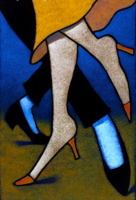Waltzing Your Way to Physical and Mental Fitness
“From a mind-body perspective, anything you do successfully on the physical end will positively affect your mental and emotional states.” commented Jenny Susser, Ph.D., a sports psychologist at the Women’s Sports Medicine Center at New York City’s Hospital for Special Surgery, a leading center for sports medicine. The article Dance Your Way To A Better Body goes on to say:
“The social aspects of dance help to make it very attractive for an increasing number of people versus, say, an elliptical training machine. Scientific studies are now also telling us that many things make dancing an excellent fitness regimen with attractive benefits,” said Polly de Mille, exercise physiologist at the Women’s Sports Medicine Center at HSS.
Of course, balanced, targeted gym workouts can provide excellent fitness benefits as well but for some people, the “fun factor” is missing at the gym.
“Those working out in gyms are often plugged into their iPods or their reading material, following their own regimen. Those dancing, however, are often moving in unison, possibly facing one another or touching, and having a communal experience. Connection and cooperation with others is integral to the experience,” she said.
 This combination of physical exercise and social connection can also be a great stress reliever, another health benefit. But, to continue on to a third out of the four pillars of health (physical fitness, mental fitness, nutritional diet, and stress reduction), dancing can provide you excellent brain exercise as well. Dr. Joe Verghese and colleagues at the Albert Einstein College of Medicine in New York found reading, playing board games, playing musical instruments, and dancing were associated with a reduced risk of dementia.
This combination of physical exercise and social connection can also be a great stress reliever, another health benefit. But, to continue on to a third out of the four pillars of health (physical fitness, mental fitness, nutritional diet, and stress reduction), dancing can provide you excellent brain exercise as well. Dr. Joe Verghese and colleagues at the Albert Einstein College of Medicine in New York found reading, playing board games, playing musical instruments, and dancing were associated with a reduced risk of dementia.
“Besides enticing folks to exercise and socialize, line dancing can also keep the brain active because dancers must learn and remember steps, [Hedy] McAdams says. It’s an appealing message for her students, many of whom are in their 50s, 60s and even 70s.”
In order to learn a dance, you must use your attention, several types of memory, motor coordination, sensory input, and executive functions, like planning. These activities involve the frontal, temporal, parietal, and occipital lobes as well as the cerebral cortex, limbic system, and cerebellum.
If you need some help figuring out which dance styles to try, check out this post on Dance Fitness at Simply Anti-Aging or this one from families.com. One of them will get you going — whether it’s with a partner or without!
Get out there and cut a rug — you won’t just dance your way to a better body, you’ll dance your way to a better brain!
Related Links
Brain Anatomy
Physical Fitness and Brain Fitness
Glossary of Brain Fitness Terms



As a ballroom dance instructor I’ve often been tempted to tape the before and after effects of social dancing on my students. I had one lady who was a senior citizen and we’d happened to take a picture of her at a dance party at the beginning of her lessons, frowning lack of confidence unable to focus. I think her husband had passed away and she felt she was unwanted by her children. (A burden). We happened to take another picture of her 5 weeks later smiling, bubbly, focused etc. I don’t know about permanent physical or chemical changes to her brain but I do know she was happy and a much clearer thinker for the social dancing and exercise. I forget how much weight she lost but it was noticeable.
What caught my attention was when I was working on her student chart and wound up putting the two pictures side by side. I labled them “before” and “after”. One small sample of what i’ve seen of my, and other teachers students mental and emotional improvement through social dance.